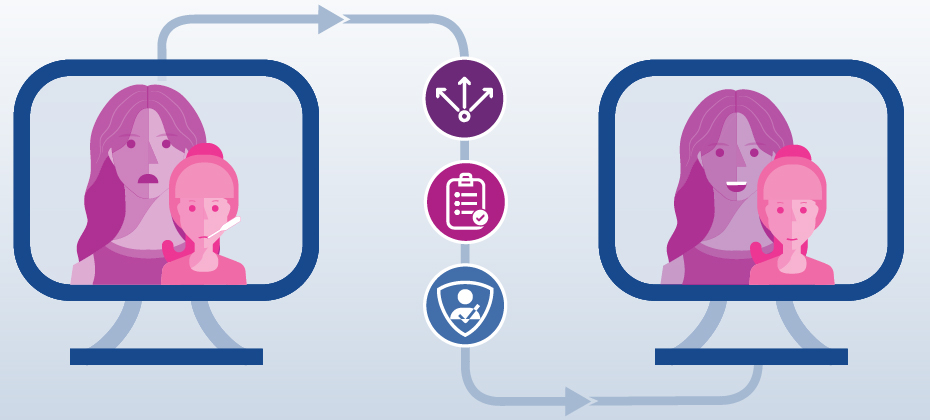Patient Access
Learn how to improve patient access by verifying critical patient information and collecting patient payments prior to service.

Imagine if every time you wanted to sign up to buy groceries online, book a vacation, or apply for a job, you had to fill out a paper registration form. For 21st century consumers who are accustomed to sleek digital and self-service experiences in industries such as retail, travel and banking, such an antiquated and cumbersome process seems unthinkable. Unfortunately, when it comes to healthcare services, we don’t have to use our imagination. Too often, we’re still required to fill out time-consuming, repetitive and tedious forms before accessing services. For providers who want to stay competitive, the long waits and wasted time that arise from paper-based registration system do nothing to win consumer loyalty. And on top of the disappointing patient experience, manual intake processes often lead to delays and errors that can disrupt the billing cycle, costing time and money further down the line. In fact, up to half of denied claims occur because of issues around the point of registration, such as identification errors, sub-standard data analytics and inefficient workflows. And at a time when patients and staff are trying to minimize face-to-face contact due to COVID-19, manual registration seems like an unnecessary extra touch point. Is it time to say goodbye to paper-based paper registration? Reimagining the patient intake experience for the digital age During registration, patients can be asked to provide personal details, submit their medical history, and confirm payer information. They may also need to schedule appointments, organize billing, or sign up for care management programs. It’s often a patient’s first glimpse of how a provider is going to look after them, so making the registration experience as stress-free as possible is a great way to build customer loyalty from the start. As the competition for consumer business heats up, providers should look for ways to give patients the virtual and mobile-friendly experience they desire, with as little time as possible spent in waiting rooms filling in forms. By letting patients tick off their registration to-do list online or via a mobile device – before even coming into hospital – providers can improve patient satisfaction, while using automated workflows to drive down costly errors and increase revenue. Here are two examples of how healthcare providers have embraced self-service registration and automated pre-registration workflows to benefit both their consumers and bottom line: 1. Schneck Medical Center used automated pre-registration to double their productivity For the patient access team at Schneck Medical Center, getting the correct patient information in a timely manner during registration was a challenge. By introducing eCare NEXT®, they were able to automate pre-registration workflows so the majority of manual, repetitive patient tasks could be completed automatically, freeing up staff to focus on patients who needed specific attention before being cleared. With Registration QA added to the mix, they could track and correct errors and spot opportunities to improve performance in real-time, for a better patient experience and more efficient operations. Skylar Earley, Director of Patient Access and Communication, said that by using Experian Health’s patient intake solutions, “we were able to make some fairly minor workflow changes, but double our pre-registration productivity on a daily basis and then repurpose some labor to different areas in patient access.” 2. Martin Luther King Jr. Community Hospital (MLKCH) used automated registration to reduce claim denials Seeing that a large portion of claim denials were originating during patient registration, MLKCH introduced an automated registration workflow to eliminate unnecessary manual tasks and increase the accuracy of the data being collected. For Patient Access Manager Lori Westman, the results have been impressive: “We get fewer denials because we’re getting true verification data, and our patient volumes continue to increase. So the fact that we can take off at least two to three minutes on half of our registrations is speeding up the work for the team, and the turnaround time is much better for the patients.” By reducing paper-based tasks and introducing automated pre-registration options, these providers were able to make life easier for patients while slimming down their workflows. Is it time for your organization to do the same? Download our free eBook to find out more about how automated patient intake workflows could help you create a seamless, more efficient patient registration experience.

Due to COVID-19 and the subsequent delay of elective procedures, many healthcare providers today are struggling to ensure their patient populations are getting the care they need. While online scheduling and referral coordination solutions can no doubt help improve patient access, especially as those who cancelled or postponed appointments look to reschedule, it’s the use of automated outreach combined with the ability to schedule appointments in real-time that can take it one step further and help providers close gaps in care. Automated outreach via interactive voice response (IVR) and text messaging (SMS) is now effectively closing gaps in care and streamlining the entire scheduling process from start to finish. Healthcare organizations leveraging automated outreach are seeing numerous benefits. Among them: Extended Outreach Capabilities – An automated and technologically advanced outreach system has far greater capacity to reach patients, when compared to the bandwidth of traditional call centers. The system enables thousands of automated calls per day that don’t require an agent to personally facilitate. Increased Appointment Bookings – Reaching more patients means more successfully booked appointments, and in turn, fewer gaps in care. Our technology successfully automates the process all the way through the booking itself, scheduling far more appointments with much less effort. Higher Patient Satisfaction – Automated outreach ensures that patients are notified on-time about any necessary follow-up care, and then provides the opportunity to quickly and easily book appointments that fit their schedule. This convenience and simplicity fosters patient engagement and satisfaction. Using a targeted outreach list, an automated calling and texting system manages the bookings, coordination and follow-up, completely lifting the burden off of the organization and its call center. Additionally, this type of technology can track metrics (i.e. response rates, booking rates, opt-outs, etc.) in real-time, allowing health plans to easily identify areas for improvement and make the necessary changes to their processes. For these reasons – as well as the benefits outlined above – a growing list of both providers, payers and ACOs are choosing to employ automated outreach technology today. Learn more about automated outreach and how it fits into an omnichannel access strategy. Learn more Contact us

Download our free eBook to find out how digital health solutions can help your organization improve the patient journey now and beyond COVID-19. You can also check out our free COVID-19 Resource Center, where you can get free access to telehealth payer policy alerts to help avoid payment denials and delays.

Financial recovery after COVID-19 is likely to be a slow burn for most healthcare organizations, according to a recent survey. Nearly 90% of healthcare executives expect revenue to drop below pre-pandemic levels by the end of 2020, with one in five anticipating a hit greater than 30%. While the return of elective procedures will be a lifeline for many hospitals and health systems, the road to financial recovery remains fraught with obstacles: Five months of canceled and postponed procedures need to be rescheduled Worried patients must be reassured of hygiene measures, so they feel safe to attend appointments Patient intake and payment processes must be modified, in order to minimize face-to-face contact As the rate of infection continues to grow, providers must find new ways to also grow their revenue and protect against a further dent in profits. The healthcare industry is unlikely to see the recovery curve hoped for across the wider economy, but digital technology, automation and advanced data analytics could help provider finances to bounce back more quickly. 4 ways technology can accelerate your post-pandemic financial recovery 1. Easy and convenient patient scheduling unlocks your digital front door Patients want to reschedule appointments that were postponed or canceled over the last few months. To manage the backlog and minimize pressure on staff, consider using a digital patient scheduling platform, so patients can book their appointments online. A self-scheduling system that incorporates real-time scheduling and calendar reminders will help to create a positive consumer experience, while offering analytics and behind-the-scenes integration to keep your call center operations running smoothly. 2. Secure and convenient mobile technology can enhance your telehealth services Telehealth is the top choice for many hospitals looking to boost revenue growth and counter the impact of COVID-19, with two-thirds of executives expecting to use telehealth at least five times more than before the coronavirus hit. Many new digital tools and strategies designed to improve the patient journey as a whole can support telehealth delivery, and help to meet growing consumer demand for virtual care. For those beginning their telehealth journey, our COVID-19 Resource Center, which offers free access to telehealth payer policy alerts, may be the place to start. 3. A digital patient intake experience can lessen fears of exposure Although many providers are starting to open up for routine in-person appointments again, patients may wonder if it’s safe. Proactive communication about the measures in place to protect staff and patients will be essential. Another way to minimize concern is to allow as many patient intake tasks as possible to be completed online. Automating patient access through the patient portal can give patients quicker and more convenient ways to complete pre-registration, while contactless payment methods are a safe way to settle bills without setting foot in the provider’s office. 4. Optimize collections to bolster financial recoveryAutomation can also play a huge role in helping providers tighten up their revenue cycle, find new ways to enhance accounts receivable collections and avoid bad debt. Tools such as Coverage Discovery and Patient Financial Clearance enable providers to find missing or forgotten coverage, and help the patient manage any remaining balances in a sensitive and personalized way. Palo Pinto General Hospital uses automated coverage checks to find out whether a patient is eligible for charitable assistance within three seconds, so self-pay accounts can be directed to the most appropriate payment plan before the patient even comes in for treatment. With fewer accounts being written off, Palo Pinto has seen a noticeable improvement to their bottom line. The pandemic has been a wake-up call for an industry that has been traditionally slow to adopt new technologies. Ahead of a second wave of COVID-19, providers must move now to take advantage of automation and digital strategies to speed up financial recovery. Contact us to find out how we can help your organization use technology to improve the patient experience, increase efficiencies and kickstart your revenue cycle.

Many patients today are forced to call the doctor to schedule an appointment. These phone calls are often inconvenient: patients are required to call during a provider’s business hours, a single call can sometimes take up to 20 minutes, or the patient may end up playing phone tag until an appointment is finally booked. The entire process bodes for a poor patient experience, but also hinders access to care as staff are only able to manage a number of phone calls per day. Like many healthcare organizations today, The Iowa Clinic wanted to improve access to care for its patients, removing the many barriers that come with having to call to schedule an appointment. Requiring a solution that could both improve patient satisfaction and operational efficiencies, the clinic, which schedules more than 600,000 appointments per year across multiple specialties, turned to online self-scheduling. With online self-scheduling, patients of The Iowa Clinic have the ability to self-schedule directly into provider’s calendars in real time from a computer or mobile device. During the booking process, patients are asked a series of brief questions and their answers are used to guide them to the right provider and appointment based on their specific care need. Appointments can be booked any time of day or night. Since implementing online self-scheduling, The Iowa Clinic has not only improved access for patients, but has enhanced operations throughout the call center, seen growth in patient acquisition and has achieved higher than average show rates. Results include: At least 15% of all appointments booked came from online during the first eight monthsThe centralized call center has seen a 30% reduction in the number of scheduling callsAt least 8 new patient appointments are booked online per provider per month Patient show rates are at 97% for appointments scheduled online Learn more about online self-scheduling and how it can help to improve patient access for your organization. “Patient Schedule allows us to improve the experience by offering a simple, convenient way to schedule an appointment online.”- C. Edward Brown, CEO, The Iowa Clinic

With a vaccine for COVID-19 thought to be at least a year away, healthcare providers are steeling themselves for even more cases in the fall. The big worry is that a surge in cases will hit the health system just as flu season takes hold. In a recent interview, Dr. Robert Redfield, Director of the Centers for Disease Control and Prevention (CDC), warned that “the assault of the virus on our nation next winter [may] actually be even more difficult than the one we just went through… we’re going to have the flu epidemic and the coronavirus epidemic at the same time.” Healthcare organizations are accustomed to an influx of sick patients between October and March: around 62,000 people died and more than 700,000 were hospitalized during last winter’s flu season. With 130,000 Americans losing their lives to COVID-19 in just four months, what could happen when the two respiratory diseases collide? Large numbers of patients with either virus (or potentially with both) will put renewed pressure on staff and services that are already under immense strain. Hospitals will need to prepare to manage both groups of patients as efficiently and safely as possible. Five ways to ease stress, paperwork and patient concerns ahead of a dual epidemic 1. Use data to drive your patient engagement strategy Create a flu preparedness patient engagement strategy to keep patients informed of how best to protect themselves in the context of a dual epidemic. As a result of the coronavirus pandemic, patients may be more familiar with telehealth services as a “contact-free” alternative to in-person appointments, so you’ll want to continue to promote these to minimize the spread of infection. With consumer data, you can segment patients according to risk and automate your communications, so they get the most relevant message at the most convenient time. 2. Relieve pressure on staff with automated patient scheduling Digital scheduling gives patients the option to book appointments online, at a time and place that suits them. This reduces pressure on call center staff and can give providers control over the volume and timing of in-person appointments, thus helping to reduce the spread of germs. An online patient scheduling platform can automate the entire scheduling process, integrating in real-time with your records management systems and connecting to your referral providers’ systems for a seamless patient and staff experience. 3. Screen patients proactively to discover their needs ahead of time Asking patients to fill out electronic questionnaires before their visit means their access needs can be identified and addressed before they come in. Do they need help to find transportation? Will they face any challenges in picking up a prescription? Is there something that could stand in the way of follow-up care? Screening for social determinants of health can answer these questions so you can direct patients to the most appropriate care and support. 4. Enable digital patient registration for a quick and easy intake experience Speed up the registration process by giving patients the option to complete their intake admin by phone or through their patient portal. Not only will this reduce the spread of infection in busy waiting rooms, it’ll make for a more enjoyable patient experience and free up limited staff resources for other priorities. With automated registration and consumer-facing mobile experiences, you can improve the patient experience, operational efficiencies and data accuracy all at the same time. 5. Minimize in-person interactions with contactless payments Encourage patients to clear their balances without having to hand over cash or access payment kiosks. Self-service digital payment tools allow patients to make contactless payments through their patient portal or from their mobile device. “The combined pressure from two viruses hitting health systems at once means it’s even more important for providers to leverage data for speed and accuracy. Automated workflows can help accelerate operational efficiency, as well as create a better patient experience during what’s already an extremely stressful time.” Victoria Dames, Vice President of Product Management for Experian Health Find out more about how Experian Health’s expertise in data and analytics can help your organization prepare for the coming flu season so you can offer your patients a safe, accessible and stress-free experience. We have also developed a checklist of action items for providers to consider as you prepare for both flu and COVID-19. How ready are you? Which actions is your organization instituting now?

For many healthcare consumers, visiting patient portals to check medical records, schedule appointments, renew prescriptions and pay bills is a no-brainer. Accessible from multiple devices at any time of day, patient portals allow patients to manage their health from the comfort and convenience of their own home. COVID-19 has been a catalyst for even more patients to consider remote and virtual healthcare services. But with large healthcare data breaches increasing by nearly 200% between 2018 and 2019, one concern continues to lurk in the background: how do providers keep patient data safe? Knowing the industry is prone to dated cybersecurity measures, hackers zero in on the lucrative medical identities market, with their top targets including: patient medical records billing information log-in credentials authentication credentials, and clinical trial information. As COVID-19 encourages more patients online, the digital doors are open for even more identity thieves to try to steal – and profit from – sensitive data. Healthcare organizations need to be confident that the person logging on is who they say they are, both to reduce the risk of a data breach and minimize HIPAA penalties. One way to balance consumer convenience with data security is to automate the patient portal enrollment process with robust patient identification protocols, making it harder for hackers to access patient information but without burdening patients. 2 ways to automate patient portal enrollment 1. Ditch activation codes that are easily misplaced Many healthcare organizations give new patients an activation code to use the first time they log in to their patient portal. Unfortunately, these tiny bits of paper or codes hidden at the bottom of lengthy enrollment documents are easily lost or forgotten. The patient has to call the office, taking up valuable staff time and resources to figure out how to log on – the opposite of streamlined and scalable. Instead, providers should consider an automated portal sign-up process. Using a combination of out-of-wallet questions, device recognition, risk models and cross-checks with linked patient data, portal access can be secured through a single platform. It’s easier and more reassuring for patients, and with far fewer calls to IT support. 2. Find quicker ways to integrate patient identity tools with existing systems The more people who need to see patient data, the more opportunities there are for cyber thieves to sneak in and access that sensitive information. Being able to share data securely between multiple providers and across different platforms is essential. During the current COVID-19 crisis, integrating authentication tools with other healthcare information systems (HIS) quickly is a huge advantage. One example is Precise ID, which can now integrate directly with Epic’s MyChart portal, Allscripts’ FollowMyHealth platform and many other HIS systems within two weeks. Jason Considine, senior vice president and general manager of Experian Health’s Patient Experience Solutions says: “Patients want to feel reassured that their data won’t wind up in the wrong hands. That’s even more important right now, as COVID-19 means more patients are choosing online services instead of face-to-face contact. With staff and cashflow under pressure, it’s even more important to get systems up and running as fast as possible. That’s why we’ve integrated with leading HIS systems to help them achieve interoperability within just two weeks.” Patient portals have the power to transform the healthcare experience for patients, but only if they can trust that their data will be kept safe. Providers can protect their patients from identity theft by adopting a multi-layered solution that incorporates best practice and cutting-edge data security technologies. Find out more about how Experian Health can help you automate patient portal security to avoid medical identity theft, so you can save money, avoid reputational damage and create a positive patient experience.

With COVID-19 leading to postponed and cancelled medical appointments, more consumers are turning to “contactless care”. Recent figures suggest telehealth adoption has shot up from just 11% in 2019 to 46% over the course of the pandemic, and some providers are seeing up to 175 times the number of telehealth patients than pre-COVID. As they grapple with the surge in patient volumes alongside regulatory change, many are playing catch-up. For patients, rushed implementation means the telehealth experience can fall short of expectations. Compared to the easy one-click services available with online retail and finance platforms, telehealth can feel clunky and frustrating. Technical issues, not knowing how to prepare for appointments, and a lack of awareness of available services can all taint the consumer experience. Providers looking to launch (or re-launch) a patient-friendly telehealth service ahead of a possible second wave should aim to check off these four considerations before rolling it out. 1. Prioritize easy online scheduling for virtual care Allowing patients to book telehealth appointments when it suits them will help to reduce no-shows and minimize delays. A telehealth platform that integrates with physician calendars and other patient management and record management systems will keep things running smoothly at the operational level, while creating a convenient and secure way for patients to schedule care. For example, when Benefis Health System implemented Patient Schedule, more than 50% of patients chose to book their appointments out of normal working hours. Sam Martin, digital developer and web specialist at Benefis, says: “If you’re not allowing your patients to schedule online, you’re behind the times. You can only benefit from it. We’re seeing the number of online bookings continue to grow every month, confirming that this solution is working for patients.” 2. Include quick and reliable coverage checks With the pandemic and resulting unemployment putting both provider and patient cashflow under strain, any available commercial or government coverage must be identified quickly. Providers should run automated coverage checks to find any missing coverage and select the right financial pathway for each patient as soon as possible. Not only will this create a more compassionate patient financial experience, it’ll allow the collections team to focus their attention on the right accounts and minimize the risk of write-offs. Automated Coverage Discovery screens for eligibility through Medicare, Medicaid or commercial plans, without any collections agency getting involved. With this tool, Essentia Health were able to find coverage for 16,990 accounts that were assumed to be self-pay or uninsured. Kathryn Wrazidlo, Patient Access Director, says: “This has helped patients because we’re actually billing their insurance versus billing them for self-pay. It’s helping staff because they’re billing the insurance company much quicker. There’s less rework.” 3. Get telehealth claims right first time Given that the pandemic may cost hospitals an estimated $200 billion between March and June 2020, there’s no room for the added financial burden of claim denials. But as telemedicine expands, so does its regulatory framework. Providers must keep track of changing payer updates and coding rules so that claims are submitted right first time. An automated, data-driven claims management tool can help providers analyze claims with greater confidence and spot any errors well in advance of submission. Telehealth alerts can be included as customized edits, to confirm whether the patient’s current plan includes virtual care. To help providers manage this process, Experian Health is offering free access to telehealth payer policy alerts through our COVID-19 resource center. 4. Protect patient data As with any part of the digital patient experience, a multi-layered approach to protecting sensitive information is a must. Ideally, this will include two-factor patient identity authentication, device recognition and out-of-wallet checks whenever a log-in attempt looks suspicious. Automating this process with a tool such as Precise ID allows providers to integrate multiple data points to check that a patient is who they say they are, in a way that’s HIPAA-compliant. This makes it harder for thieves to access patient data, without burdening the patient with extra checks as they manage their information. Retaining patient volume and rebuilding revenue through “contactless” care won’t be possible unless the entire telehealth journey is as seamless as possible. From scheduling to payment, Experian Health can help you create a virtual patient experience that’s convenient, secure and reliable. To learn more about how to build a better digital patient journey, download our free eBook.

Consumers today expect fast and convenient access to almost everything, healthcare included. While still only offered by a fraction of healthcare providers out there, online scheduling is catching on throughout the market – especially as more providers turn to telehealth solutions during COVID-19. Still, despite the uptick in online self-scheduling, there are patients who prefer to call to schedule an appointment and call centers may be overwhelmed as a large number of patients rush to reschedule appointments that were cancelled or postponed due to COVID-19. To best prepare, providers will want to ensure the best possible patient experience for those calling to schedule an appointment. This can be done by enabling online scheduling throughout the call center. Here are five ways to make patient scheduling easy through your call center: Save timeWith a manual scheduling process, patients often have to sit on the phone – sometimes for upwards of twenty minutes – while also being put on hold or having to wait to be called back to confirm an appointment. It’s not only an awful patient experience but imagine what all that time adds up with the number of scheduling calls providers receive every single day? By reducing call times you’re making the process more efficient for more routine scheduling calls while also opening up call center agents to focus on those patients who need more attention. Automate the rulesThe key to reducing time spent scheduling an appointment is automating the scheduling protocols and business rules of the providers in the scheduling platform. Call center agents traditionally have to manually navigate expansive spreadsheets or three-ring binders of business rules with the scheduling criteria for each provider. Experian automates all those rules in our system and translates them to easy Q&A prompts for the scheduler while on the phone with a patient. In short, rules automation equals quicker scheduling (while maintaining accuracy). Improve trainingBecause the rules are automated, the training process for call center agents is made much more efficient. Where agents would have had to learn the various nuances of scheduling complex specialty care for a variety of providers, they now just need to learn how to use the scheduling platform. The scheduling protocols are automated and help dialogues will pop-up to explain and guide agents through the scheduling process for every provider and care type. Where it may have taken 60 to 90 days to master scheduling for a new specialty, schedulers can now be experts for that specialty in as little as one hour. IntegrationIn order to get the most out of any scheduling solution it needs to integrate into the provider’s practice management system. Leveraging APIs or HL7 bi-directional connectivity, all bookings occur in real-time. This prevents any double-bookings and also removes any calendar maintenance by staff to block and recheck time for providers. With the integration, bookings from the call center transact the same as if a staff member was logged in at the providers office and scheduling on the spot. Automated outreachProviders can use automated outreach to augment their call center capabilities. With it they can send text message and IVR campaigns to patients with the ability for patients to schedule an appointment in real-time on the phone. Check out Patient Schedule to learn more or download our free guide about how scheduling can be made easier for your patients through all of your access channels.